Yeah, it turns out that I still don’t like Sam & Max Hit The Road.
It’s not for lack of effort on my part. I have tried to play it several times over the last twenty-five years, and yet never made it more than an hour in. There’s something about its particular brand of wacky cartoon meta humour that just rubs me up the wrong way, and always has done. Playing Sam & Max is basically like playing an internet webcomic come to life, except I’ve just had to sit through two decades of increasingly shitty internet webcomics and so experiencing it in full for the first time in 2020 rather than 1993 hasn’t exactly improved it much. Being ahead of the curve on something that was subsequently run so far into the ground it’s now tunneled an appreciable fraction of the distance to the Earth’s core is not really Sam & Max’s fault, and my dislike of its humour is a purely subjective thing. (Although I would stand by my opinion that this wasn’t funny even back in the ‘90s.) However, Sam & Max is also a tremendously frustrating game to play today for two other reasons, one of which we’ve seen before in this series, and one of which is entirely new.
If you have been following these posts for a while, you’ll know that I started with Maniac Mansion, which was the first adventure game to move to a mouse-driven interface by putting its action verbs on screen and allowing the player to construct commands by clicking on a verb and then something in the environment. It was a big improvement over what came before, and up until this point all other LucasArts adventure games (with the exception of Loom) have used an identical interface with the verb list and the inventory taking up the bottom 40-50% of the screen. This is, obviously, a huge amount of space to devote to an interface, but that didn’t matter so much back in the late ‘80s because 1) computers were much less capable so the less actual on-screen art they had to draw the better, 2) the art was much uglier, and 3) everyone was doing big chunky interfaces at the time anyway. As computers became more powerful and the art and the animation improved, however, only being able to use half the screen to show it off must have really rankled with the LucasArts artists. And given that Sam & Max is in many ways a statement of just how good they’d gotten at comic book-style 2D art — the one nice thing that I will say about Sam & Max is that it still looks phenomenal 27 years later — it is not surprising that it’s also the first game to do away with the verb interface entirely.
That’s not to say that it gets rid of the actions, though, and this is where Sam & Max comes a cropper. PUSH and PULL are gone, but PICK UP, USE, LOOK and TALK TO are all still here as discrete actions (GIVE is now context-sensitive and is achieved by using an inventory item on an NPC) and WALK TO is now more important than it has been in any previous LucasArts adventure thanks to the way Sam & Max handles them. Actions are accessed via one of two methods: either clicking on the box in the corner of the screen which brings up Sam’s inventory — helpfully blocking the entire screen in the process — in which he stores all of his actions as inventory items, or else right-clicking to cycle through each action symbol on the mouse cursor. In practice this means that USING an object has gone from two clicks (click USE, click object) to either four (click inventory, click USE, click inventory again to close, click object) or anywhere between three and five depending on which action your cursor is currently set to and how far away it is from USE in the action cycle — it could be the next one, in which case you get away with three, or it could be the previous one, meaning you have to click through the other four actions before getting back to USE.
Needless to say, in pure interface terms this feels like a step backwards as executing simple actions feels much clunkier than the (relatively) elegant flow of the verb interface. The mechanical process of playing Sam & Max is more annoying than any LucasArts adventure game since Indiana Jones And The Last Crusade, especially because the game makes the baffling choice to remove text tooltips entirely. What this means is that we are, essentially, back to the bad old days of WHAT IS, as mousing over an object will not tell you what it is; you’ll have to get Sam to walk on over and LOOK at it. Since the noisy art style obfuscates what is and isn’t interactable this makes the game’s already obtuse puzzles even harder to solve because you cannot tell, just by looking at a scene, what the points of interest are; you have to wave LOOK around, wait for the cursor to switch from a closed eye to an open eye, click on the thing, then wait for Sam to amble on over (he is the slowest adventure game protagonist yet) and describe what it is, and then repeat the process until you’ve found all the objects of interest. Not that you can be sure you’ve gotten them all, because there’s simply no way to tell; more than once during my playthrough I checked a walkthrough to discover that I’d missed multiple items despite doing thorough sweeps with LOOK.
The low readability and lack of feedback is a dramatic step backwards from Day Of The Tentacle, but Sam & Max isn’t content to leave it there: its war on tooltips extends to the conversation interface too. I guess the thinking here went along the lines of, oh, we replaced the text-based inventory system with a set of icons representing the player’s items back in Monkey Island 2 and it worked really well, so what if we also replaced the player’s available conversation topics with a set of icons? This is why, instead of the normal list of sentences representing things that Sam can say next, he’s forced to choose from a series of abstract pictograms. Because Sam & Max hates tooltips you can’t mouse over the pictograms for a description of what they actually are, so conversations in Sam & Max are a frustrating process of trial and error as you click on things randomly to try and figure out what the hell Sam is going to say. Here’s a typical example:
Oh yeah sure, I’ll just ask this circus guy about Rubber Duck, and then maybe follow it up with a question about Hand. This is the problem with this system: conversations are abstract and indefinite concepts that don’t translate well into a symbolic form (or even a truncated text-based one, as modern conversation wheel-based RPGs have sometimes learned to their cost). If you have specific things to ask about then it’s a bit easier as it’ll flash up a picture of that thing, but while I quickly realised that Hand meant “end conversation” I never really figured out what, exactly, the other three options were for. Question Mark makes Sam ask a question, but you can never tell what the question is going to be about until you ask it. Exclamation Mark usually makes him insult the person he’s talking to, which is not really what I was expecting from it. The worst thing about it is that some of these generic conversation options open up other, specific conversation options once selected, but because you don’t know what Sam will say when selecting one of the generic ones there’s no way of following that chain of logic; all that you can really do is push the pretty buttons one at a time until something happens. In every conversation.
(And this is all leaving aside the fact that making the conversation interface so impenetrable makes it useless for the actual most important thing a conversation interface should be doing in an adventure game: giving the player hints and/or direction. God knows Sam & Max could use some.)
Playing Sam & Max is painful. There’s no getting around that, really; even if this interface was attached to a much better game, which Sam & Max is not, it would still be awkward and unpleasant. It did arguably clear the way for Full Throttle and The Dig to also ditch the on-screen action verbs, and both of them learned from Sam & Max’s mistakes with much better takes on the same basic concept. Perhaps it was necessary for Sam & Max to trip over its own feet and pants itself so that those other games could run, but knowing that didn’t make the experience of playing it any better for me. It’s a big step backwards in usability, although not to the point of being unusable; it is, perhaps, the sort of thing I’d put up with if the writing was good and the puzzles were clever.
Alas, Sam & Max is neither.
To understand why, you need to understand how Sam & Max came to be at all. The characters of dog-detective Sam and his psychotic rabbit sidekick Max were not invented for this game; they’re the much older creations of LucasArts artist Steve Purcell, having been featured in their own comic series in the late ‘80s and subsequently adopted as something of an unofficial corporate mascot for LucasArts. Sam and Max were used as training material for onboarding new artists and animators and made cameos in many LucasArts adventure games, starting with Indiana Jones And The Last Crusade. And eventually LucasArts thought, well, Steve has these semi-popular characters that our own employees clearly love, so why don’t we ask him if he wants to make a game featuring them? Steve Purcell obviously said yes, and that’s how we got Sam & Max Hit The Road, which is based on a storyline from the comic book.
This is why Sam & Max is the way it is: a self-indulgent, nonsensical, incoherent mess which basically doesn’t have a story and where the puzzles make no sense whatsoever, but which has incredible art and animation because the artists and animators were 100% bought into the concept of making a Sam & Max game and had been already been drawing the pair of them for years. There is so much bespoke animation in Sam & Max’s cartoon world that it really has to be seen to be believed; there’s detailed, one-off animations for nearly every interaction in the game, including a few failed ones, and you can tell the art team was having an absolute blast with it. It also explains why the interface has been switched around to be so visual with zero text outside of the subtitles, since this is a project where the artists are firmly in the driving seat.
But for all of the extra attention paid to Sam & Max’s outstanding visuals, it seems like there was even less effort than usual spent on making the actual game good — at least, for people who hadn’t already read the comic book and who weren’t fully on board with the world and characters of Sam & Max. One of the very first puzzles in the game is finding the orders from the police chief so that you can show them to the fire-breathing guy guarding the entrance to the circus so that he’ll let you in. They are, initially, nowhere to be found; there’s the sound of a courier showing up in the street outside their office, but once you trundle on down there there’s no mailbox or anything that would obviously contain the orders. In fact the only interactable object in the street is a cat, so obviously the orders are inside the cat. Obviously. Even if you figure this out, you then have to work out how to get the orders out of the cat, which is to get Max to put his arm down the cat’s throat and extract the orders by force.
This puzzle encapsulates everything I hate about bad adventure game puzzles, and everything I hate about Sam & Max. The awful interface and conversation system offer next to no help as to what the possible solution to each puzzle might be, so you’re forced to figure everything out on your own. The solution itself is governed by cartoon logic, so it’s completely unpredictable and forces you to fall back on a use-everything-on-everything approach. And it’s not just this one puzzle, either, because nearly every puzzle in the game is constructed the same way, like the designers felt that they had to try and outwit their players with something unsolvable instead of giving them something that was merely challenging. There’s many famous examples of Bad Adventure Game Puzzles, like getting the key from the subway track in The Longest Journey or the cat hair moustache puzzle from Gabriel Knight 3, and I don’t understand why Sam & Max gets a pass when these lists are compiled because, unlike Monkey Island 2 where the monkey wrench puzzle and the non-alcoholic grog puzzle were notable blips in a game that mostly worked on regular human logic, it’s an entire game of bafflingly obtuse horseshit.
Maybe it’s more acceptable if you like the styling and the humour and what little story Sam & Max actually has, but I unfortunately do not. Both Sam and Max are deeply unpleasant characters to spend time with — I guess this is supposed to be the joke and I’m supposed to be laughing at them, not with them, except it doesn’t exactly endear them to me to the point where I’m willing to spend a game’s worth of time in their company. The theming of the game is based around a road trip around a series of ludicrous tourist traps such as the World’s Largest Ball Of Twine, and Sam & Max in general is suffused with a love of tacky, chintzy Americana that I’m not convinced translates all that well outside of it. There’s a lot of cultural in-jokes in here that you either get (if you’re from the US) or you don’t (if you’re from the rest of the world) and if you’re in the segment of the population that doesn’t then the entire game is in danger of misfiring. Sam & Max certainly leans on that cultural knowledge far more heavily than Day Of The Tentacle did — where all you really need to know to get most of the jokes is that George Washington and the Declaration of Independence are things that exist — and my not being in on the joke contributed significantly to my dislike of the game in general. Not to mention Sam & Max being the first of two LucasArts adventures that think giving their villains an Australian accent is inherently funny1.
So. I apologise if you’re reading this and you happen to be a big fan of Sam & Max. Perhaps you do fall into the target audience for its humour, or perhaps you’re really into its art and animation; it’s not like Sam & Max does everything wrong, and even the worst LucasArts adventure games have made important contributions to the evolution of adventure games in general. Sam & Max’s contribution does at least mean that this is probably the last time I have to put the boot into a beloved classic quite this hard, as they figured out how to do textless interfaces properly after this and never repeated the mistakes made here. However, that LucasArts’ subsequent output was far better for Sam & Max existing doesn’t excuse the fact that Sam & Max itself has at best aged absolutely terribly, and at worst is comfortably resting at the nadir of the LucasArts adventure game catalogue along with Zak McKraken and Fate Of Atlantis, and it is most definitely not something that I’d recommend playing in 2021.
- It at least made a modicum of sense in Escape From Monkey Island, where Ozzy Mandrill is supposed to be a pisstake of Rupert Murdoch. ↩

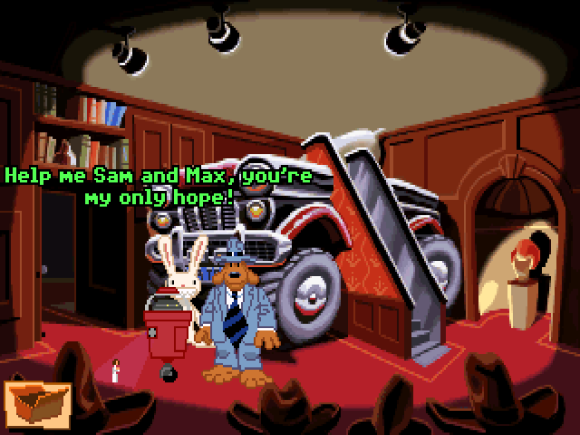
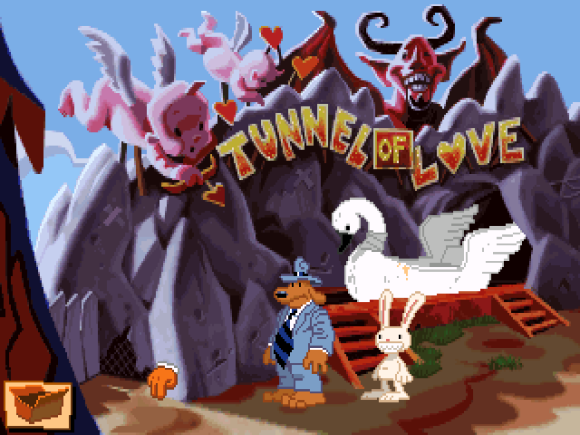
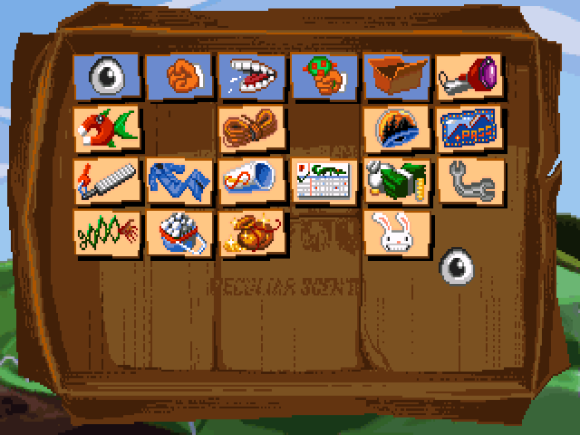
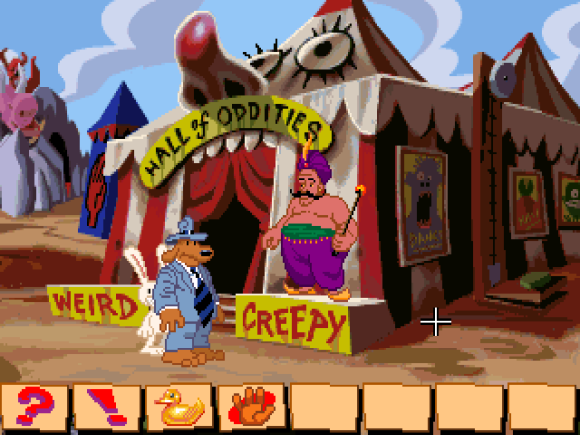
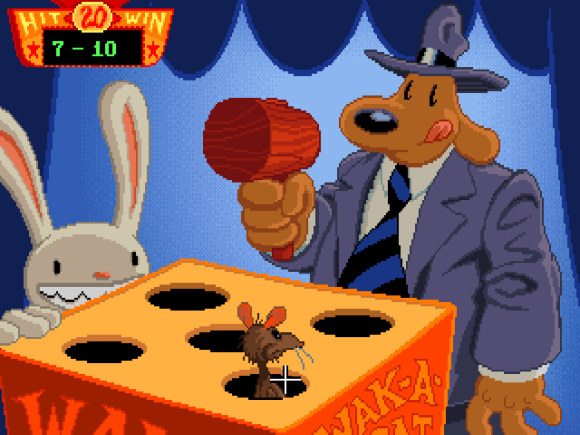

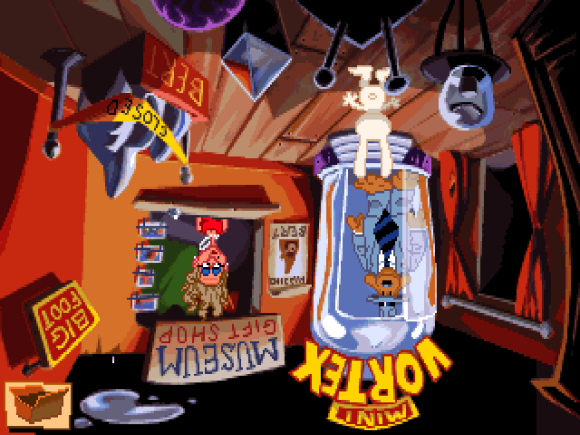
I tend to agree with you in terms of the game design. I remember not getting the praise Sam & Max was getting everywhere. However, I do enjoy the jokes and the atmosphere. Maybe it is an American thing.
In terms of things getting better… there’s not much left, and what’s there isn’t that amazing, so don’t set your hopes too high.
Thank you mate – finally a review that removes (or perhaps, never wore) the rose coloured glasses and objectively assesses this game on its merits. I hadn’t ventured beyond Day of the Tentacle back in the day, as the first time I tried to give Sam and Max, Full Throttle and The Dig a go, I instantly found the interface cumbersome and jarring.
Fast forward 25 odd years, and I gave Full Throttle another crack on the suggestion of a mate, and you know what… I kinda liked it. The puzzles were too easy and I finished the game in under 5 hours without help, but the atmosphere was absorbing and the fact I wanted more says *something* about it. Interface wise, whilst I still didn’t love it, I thought it was actually pretty serviceable. So I vowed to give Sam and Max another go.
Yeah, you pretty much nailed my thoughts. More than cumbersome, I found the interface a distraction, the puzzles were too non-sequitur and at no time did I feel a sense of accomplishment in working anything out… my post-solve reactions spanned from “you’ve got to be kidding” to “I’m sure I tried that” to “meh”. There were several times I was sitting there thinking “So what am I meant to do next?” and when I did stumble across it, it was a case of “But why?”.
I can pinpoint the moment any potential enjoyment of this game was lost, and I just became frustrated by everything it did after that point, and it pretty much covers the gamut of your critique… *** SPOILER ALERT *** I had set up the binoculars in the restaurant to find Frog Rock but Sam kept complaining that things were too small to make out any detail. Hang on, aren’t these things binoculars already – isn’t their purpose to magnify? OK, whatever. I spent 45 mins visiting every place I could to try and find something to solve this “puzzle”. The whole absurdity of the game meant that it could be anything at this point, but nothing surfaced. I thought Shuv-Oohl’s eyeglasses might have been a logical choice, but no. In the end, I had to use a hint and *** FINAL SPOILER ALERT *** it turns out there was a magnifying lens a couple of pixels away from Whack a Rat back at the circus. So my issues here: a) The puzzle itself is inane. There’s nothing clever here, it’s just object hunt padding. b) The interface made finding this really difficult. I’d scanned this location with the eyeball, but often “My little buddy Max” was in the way, so that could be why I missed it Could also be that I thought the open eyeball (which was the size of the entire midway games tent) was still open for Whack a Rat. c) Even when I knew it was there, I looked at the dark blob of pixels and thought it looked more like a hoop you’d throw a ball through…. Why would there be a giant magnifying lens in this location? Is it a typical American funfair thing? Good puzzles should lead you to the vicinity of their solution intuitively. Good puzzles should actually be puzzles.
Anyway. The art style was great for its time, and I get that it would be some people’s kind of humour (I had the odd chuckle, but I became tired of it – I felt it became the game’s crutch), but yeah… this goes into my “Overrated” pile, and I won’t be playing it again, Sam.